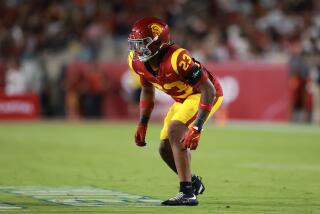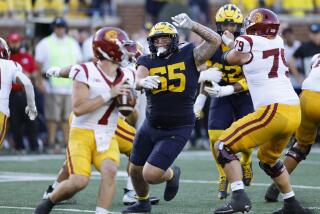USC’s Jurrell Casey pushes adversity to the side
- Share via
Jurrell Casey has been a starter at USC only one season, but the junior defensive tackle from Long Beach is projected by several NFL draft prognosticators as a first-round pick next April.
Not that he spends much time thinking about it.
“At this point, you kind of like put it to the side,” he said. “No distractions.”
Even through hardship.
Casey proved that during his final two years at Long Beach Poly High after his older brother, a college football prospect himself, was arrested and later convicted of murder.
At USC, the 6-foot-1, 305-pound Casey has excelled despite playing for three position coaches in two-plus years, drawing praise and comparisons to former Trojans All-Americans Mike Patterson and Sedrick Ellis.
New defensive line coach Ed Orgeron loves Casey’s attitude and build, but he has reserved judgment before putting him in the same category as players selected 31st and seventh overall in the NFL draft.
“He shows signs, he shows capabilities, but he has to do it on a consistent basis,” said Orgeron, who also tutored Patterson and Ellis during a previous coaching stint with the Trojans.
Casey agrees, and he intends to quietly lead a defensive line that is regarded as the strength of a USC team facing its own focus-related challenges. NCAA sanctions have left the Trojans on probation and ineligible for a bowl game.
USC Coach Lane Kiffin, an offensive assistant for the Trojans when players such as Patterson, Ellis, Kenechi Udeze and Shaun Cody terrorized opponents under Orgeron’s tutelage, has raved about the defensive line since spring practice. Nose tackle Christian Tupou must sit out the season while recovering from knee surgery, but the line still features ends Nick Perry, Wes Horton and Armond Armstead and nose tackles DaJohn Harris and Hebron Fangupo.
Casey, who utilizes speed, strength and leverage to overpower opponents, will be at the other tackle spot.
“He frees me up because a lot of teams are going to try and double-team him,” said Armstead, another top pro prospect. “He’s always humble, but he’s a beast on the field.”
As a baby, Casey’s mobility apparently resembled that of a reptile.
His mother, Collette Burns, laughs heartily when recalling how the youngest of her four children earned his nickname.
“One of his aunties said he looked like a little turtle crawling around, so she called him Tut-Tut,” Burns said. “That name just followed him.”
Casey took the name to Poly, where his brother, Jurray, was establishing himself as a star defensive end and linebacker. Jurrell played as a reserve for the varsity as a sophomore and was proud when his brother committed to Oregon after being selected as the co-defensive player of the year in the Moore League.
But in January 2006, Jurray and another man were charged in connection with a fatal shooting of a 17-year-old boy in Culver City. A year-and-a-half later, Jurray, 19, was convicted of first-degree murder and shooting at an occupied vehicle. He was sentenced to 50 years to life in prison.
“Jurrell was hurt in his own way, but he never showed it,” his mother said.
“When everything happened, I just knew it was my turn to step up and be the man of the house and take care of the family,” Jurrell said. “That happening inspired me to go out and work even harder. After me there was no one else.”
Poly High Coach Raul Lara said his staff kept an eye on Casey and watched him channel his emotions into football.
“It was rough at the beginning when everything first was happening, but I’ve always been very strong and don’t let things get to me very much,” Casey said. “When I go out there on the field and focus on things I get my stress out.”
His brother’s situation, he said, kept him moving toward his own goals.
“You always learn something from something negative, you know, to choose friends wisely, who to be around, when something is about to happen to go the other way. … From there I just stayed focused in school to get my grades right to get ready to come to college and focus on football.”
Casey chose USC over Oregon and played as a backup nose tackle under former defensive line coach Nick Holt as a freshman. Last season, Jethro Franklin moved him off the center to the other interior line position and Casey had nine tackles for loss, including 4½ sacks.
Orgeron replaced Franklin in January, Casey well aware of the fiery coach’s reputation for tearing players down and building them back up.
“Back in the day, he was kind of crazy, a wild man,” Casey said, chuckling. “He kind of calmed down a little bit.”
Orgeron still made it clear to Casey that he needed to play harder and more consistently.
“The first time he said that, I was like, ‘I’m out here first through fourth down!’ ” Casey said. “But if you go back and look at the film, there are a couple plays I take off here and there.
“I understand where he’s coming from. To be great you have to go every down. Every snap you have to play at the same pace.”
twitter.com/latimesklein
More to Read
Go beyond the scoreboard
Get the latest on L.A.'s teams in the daily Sports Report newsletter.
You may occasionally receive promotional content from the Los Angeles Times.







